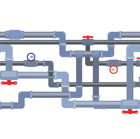Piped-services quick fixes

As in any trade or profession, there are days in the life of a building services engineer when the only thing that will do is a quick fix. For those occasions when the clock is ticking, the pressure is on, a solution must be found ... and found quickly. Paul Wightman of Albion Valves shares some simple and cost-effective tactics to tackle energy wastage.
You don’t need to be an engineer to know that noisy pipes in a heating system can create a very literal headache — vibrations and whistling are problems that need to be fixed and fast. However, the root cause of the issues can often be difficult to identify, and fixing it can be a complex task.
In some instances, a breakdown in a heating system resulting in noisy plumbing may be due to a change in conditions — for example, following a pump failure which can result in higher pressure levels than the original system had been designed to accommodate.
Noisy heating systems can also be due to excessive intervention in the system over time from heating engineers. Treating problems and making minor modifications, tweaks or additions to a system can inadvertently affect the smooth running and magnify the problem.
The installation of DPCVs (differential pressure control valves) needs careful consideration, but a timely intervention with a few appropriately sized and selected valves installed at the correct locations can make all the difference towards solving noise and vibration problems within circulation systems such as described above.
Failures such as pumps overheating and seizing may be due to lack of by-pass allowance within existing systems. Checking that these are both installed and set-up appropriately may resolve repeat failures which are a costly symptom rather than a cause of system malfunction.
It should also be kept in mind that these ear-splitting symptoms could be avoided entirely if the proper process was adhered to during the design stage and care had been taken to consider layout, location and sizing of pipework.
Water leaks and overzealous heating or cooling systems waste energy and haemorrhage money. For commercial buildings such as schools, office blocks and retail outlets, wastage from leakage and unnecessary heating or cooling can be simply solved by the use of solenoid valves.
Solenoids are an invaluable and inexpensive preventative measure that can be easily fitted to increase the efficiency credentials of older systems, by preventing dripping taps, non-closures and leaks to save water.
Similarly, to avoid wastage on a hot-water system in a commercial building, engineers could consider updating to 2-port PICV (pressure independent control valves) for hydronic balance control, meaning only the water required is delivered to a specific location with no wasted energy. Hence, the 4-port constant volume system could be upgraded quite easily and cost-effectively at each terminal unit to a variable volume system —offering significant savings, even on older installations.
Similarly, if the pipework is in good condition on a HVAC project, then the terminal units such as FCUs, overdoor heaters and internal water coils are likely to be equally sound. This is central to the delivery of the water service and may not need replacing. However, to boost efficiency, comfort and performance, the controls may benefit from improving speed control on the fan to optimise airflow over the coil, which can add years to the system’s service life.
In older or dirty systems that often occur in public buildings, engineers called out to provide a quick fix should check the system has included strainers and non-return valves and ensure that these are fitted correctly and that the mesh is clean. Simple and regular housekeeping is often the answer, and prevention is always better than cure.
Non-return valves are generally, small, simple, inexpensive and work automatically. They are designed to prevent a backflow of product into a system promoting optimum levels of cleanliness and helping to ensure the smooth running of the system and greater longevity.
Time and resource wastage can be avoided by thoughtful specification of equipment from the outset. Quite simply, manual valves that require a lot of attention should be replaced with modern automated valves; manual interaction invariably means poor control.
New regulations, directives and adhering to compliance policies to ensure equipment is fit for purpose can cause one of the greatest problems for engineers. It can take a lot of time and research to identify which product is suitable for which application.
Where compliance is a minefield, Albion has delivered a quick fix to help take the issue away from specifiers and has prioritised approvals and accreditations across their product portfolio assuring that the products they specify are fit for purpose and fall within new legislation.
One of the best-loved quick fixes across the building services industry are press fit valves — the ‘sticking plaster’ equivalent, they are quick and easy to install without the need for tools.
Although press-fit tooling can be expensive, they make installation much easier — especially where space is limited such as within roof voids or under floors. Using press-fit valves and components will often prove to be an essential piece of equipment for site-management and heating/cooling engineers.
Paul Wightman is technical specifications manager with Albion Valves.







